Crew 54 – 754th Squadron – Assigned October 1943

Shot down by ME410 Night Fighter Intruder 22 April 1944
| Rank | Name | Serial # | Pos | Date | Status | Notes |
|---|---|---|---|---|---|---|
| 2Lt | Charles W Stilson | 0536780 | Pilot | 03-Jul-44 | CT | Trsf to 12RD - Tour complete |
| 2Lt | Joseph E Worton | 0807093 | Co-pilot | 06-Aug-44 | UNK | TD AAF 101 - Central Med Bd |
| 2Lt | Raymond E Sawyer | 0811767 | Navigator | Jul-44 | CT | Awards - Distinguished Flying Cross |
| 2Lt | Melvin C Marshall | 0752764 | Bombardier | 22-Apr-44 | DOW | Cambridge American Cemetery |
| T/Sgt | William R Pearce | 12156599 | Flight Engineer | 22-Apr-44 | KIA | New York County, NY |
| S/Sgt | James H Blake | 17169314 | Radio Operator | 01-May-45 | UNK | 2AD Roster - 96 CBW HQ |
| S/Sgt | Arthur Silverman | 11113837 | Gunner | 22-Apr-44 | KIA | Norfolk County, MA |
| T/Sgt | Clarence C Connelly | 13143715 | Gunner | 12-Jul-44 | INT | Intenered Switzerland - H. Hopkins |
| S/Sgt | Herbert F McBride | 34394265 | Ball Turret Gunner | 06-Jul-44 | CT | Reld from 60SC |
| Sgt | William L Johnson | 34257791 | Gunner | 23-Jul-44 | CT | Reld from 60SC |
Crew 54 was originally commanded by Lieutenant Frederick E. Savage (0-745846) during third phase training at Tonopah, Nevada. At some point prior to December 1944 he was replaced as pilot by the co-pilot on the crew, 2Lt Charles W. “Red” Stilson. Taking Stilson’s place as co-pilot was Lt J. Edward Worton, likely an individual replacement in January 1944. Sgt. Lee Roy Frady (38371355), listed as “lower turret gunner” was also replaced by S/Sgt Herbert F. McBride before the crew completed their training.
The crew flew their Liberator, a B-24H they had named Belle of Boston, via the Southern Ferry Route to the European Theater. On February 4, 1944 they were forced to land at Rinneanna Airfield in neutral Ireland where they were interned for a week or so. It is not clear what necessitated their landing. Official records state “lost bearings, low on fuel, and claiming radio problems”, while another source puts the blame on an encounter with a bird through the cockpit windshield. The aircraft was released on February 10th and continued on to Horsham St. Faith.
The crew flew their first mission on March 5, 1944 to Bordeaux, France and followed that up on March 6th & 8th with two trips to Berlin although one of these had to be aborted. Over the next month the crew flew eight missions to Germany and four to France. All but their first two missions, and their last as a crew were flown in Belle of Boston.
On April 22, 1944 the crew took off, along with 27 other 458th B-24s, late in the afternoon to hit the marshalling yards at Hamm, Germany. After releasing their bombs on the primary target, their formation headed for home. As the group approached the English coast, ME-410 night fighters, using cover of darkness attacked the Liberator formations. Stilson’s crew was shot down near Horsham St. Faith and T/Sgt William R. Pearce, engineer and S/Sgt Arthur Silverman, gunner were both killed. 2Lt Melvin C. Marshall, navigator, died in the base hospital the next day from wounds received in the crash. (See detailed account of this action below & 458th BG Report to Gen Spaatz.)
After this harrowing experience, it appears that two members of the crew were removed from flying status. Sgt William L. Johnson, tail gunner, was reclassified as an Airplane Armorer. S/Sgt James H. Blake, the crew’s radio operator was reduced to Private, but no indication is given as to the reason for this. Both men were briefly assigned to the 60th Station Complement on base until released in July 1944.
S/Sgt Herbert F. McBride was not on the April 22nd mission, his place being taken as ball turret gunner by S/Sgt Kenneth Katten from Crew 55. Katten was severely wounded and received the Purple Heart in May, and the Distinguished Flying Cross in July for his actions that night. Also wounded when he bailed out at low altitude was co-pilot 2Lt Joseph E. Worton. McBride completed his tour, but it is not known if Lt Worton flew additional missions after April 22nd.
2Lt Raymond E. Sawyer completed his tour of missions in June or July and was awarded the Distinguished Flying Cross.
1Lt Charles W. Stilson flew additional missions, with several different co-pilots through June and completed his tour. On May 14, 1944 he was awarded the Silver Star for his actions on the night of April 22nd.
Missions
| Date | Target | 458th Msn | Pilot Msn | Serial | RCL | Sqdn | A/C Msn | A/C Name | Comments |
|---|---|---|---|---|---|---|---|---|---|
| 05-Mar-44 | BORDEAUX/MERIGNAC | 3 | 1 | 42-100362 | A | Z5 | 2 | SWEET LORRAINE/BOOMERANG | |
| 06-Mar-44 | BERLIN/ERKNER | 4 | ABT | 41-29331 | F | J3 | -- | BLONDIE'S FOLLY | ABORT - R/O OXY LEAK |
| 08-Mar-44 | BERLIN/ERKNER | 5 | 2 | 42-52404 | Q | Z5 | 1 | BELLE OF BOSTON | |
| 15-Mar-44 | BRUNSWICK | 7 | 3 | 42-52404 | Q | Z5 | 2 | BELLE OF BOSTON | |
| 16-Mar-44 | FRIEDRICHSHAFEN | 8 | NTO | 42-52404 | Q | Z5 | -- | BELLE OF BOSTON | NO TAKE OFF |
| 23-Mar-44 | OSNABRUCK | 12 | 4 | 42-52404 | Q | Z5 | 3 | BELLE OF BOSTON | |
| 27-Mar-44 | BIARRITZ | 15 | ABT | 42-52404 | Z5 | -- | BELLE OF BOSTON | ABORT - #3 FUEL CAP | |
| 05-Apr-44 | ST. POL-SIRACOURT | 16 | 5 | 42-52404 | Q | Z5 | 4 | BELLE OF BOSTON | |
| 10-Apr-44 | BOURGES A/F | 19 | 6 | 42-52404 | Q | Z5 | 6 | BELLE OF BOSTON | |
| 11-Apr-44 | OSCHERSLEBEN | 20 | 7 | 42-52404 | Q | Z5 | 7 | BELLE OF BOSTON | |
| 12-Apr-44 | OSCHERSLEBEN | REC | -- | 42-52404 | Q | Z5 | -- | BELLE OF BOSTON | RECALL |
| 13-Apr-44 | LECHFELD A/F | 21 | 8 | 42-52404 | Q | Z5 | 8 | BELLE OF BOSTON | |
| 18-Apr-44 | BRANDENBURG | 22 | 9 | 42-52404 | Q | Z5 | 9 | BELLE OF BOSTON | |
| 19-Apr-44 | PADERBORN A/F | 23 | 10 | 42-52404 | Q | Z5 | 10 | BELLE OF BOSTON | |
| 20-Apr-44 | SIRACOURT | 24 | 11 | 42-52404 | Q | Z5 | 11 | BELLE OF BOSTON | |
| 22-Apr-44 | HAMM M/Y | 25 | 12 | 42-100357 | D | Z5 | 10 | VALE OREGAN | SHOT DOWN, INTRUDERS |
| 04-May-44 | BRUNSWICK | 34 | 13 | 42-95018 | J | Z5 | 6 | OLD DOC'S YACHT | |
| 07-May-44 | OSNABRUCK | 36 | 14 | 42-52404 | Q | Z5 | 12 | BELLE OF BOSTON | |
| 10-May-44 | DIEPHOLZ | REC | -- | 42-95165 | S | Z5 | -- | COOKIE | RECALL BEFORE EC |
| 11-May-44 | EPINAL | 39 | 15 | 42-95165 | S | Z5 | 1 | COOKIE | |
| 12-May-44 | BOHLEN | 40 | 16 | 42-95165 | S | Z5 | 2 | COOKIE | |
| 24-May-44 | VILLEROCHE | 46 | 17 | 42-95165 | S | Z5 | 7 | COOKIE | |
| 25-May-44 | MULHOUSE M/Y | 47 | 18 | 42-110070 | E | Z5 | 1 | ELMER / LADY LUCK | LEAD 2nd SECTION |
| 27-May-44 | NEUNKIRCHEN | 48 | 19 | 42-95165 | S | Z5 | 8 | COOKIE | |
| 28-May-44 | ZEITZ | 49 | 20 | 42-95165 | S | Z5 | 9 | COOKIE | |
| 29-May-44 | TUTOW A/F | 50 | 21 | 42-95165 | S | Z5 | 10 | COOKIE | |
| 02-Jun-44 | STELLA/PLAGE | 53 | 22 | 42-95165 | S | Z5 | 11 | COOKIE | |
| 06-Jun-44 | COASTAL AREAS | 56 | 23 | 42-95165 | S | Z5 | 12 | COOKIE | MSN #1 |
| 06-Jun-44 | PONTAUBAULT | 58 | 24 | 42-95165 | S | Z5 | 13 | COOKIE | MSN #3 |
| 08-Jun-44 | PONTAUBAULT | 60 | 25 | 42-95165 | S | Z5 | 14 | COOKIE | |
| 10-Jun-44 | CHATEAUDUN | 61 | 26 | 42-95165 | S | Z5 | 15 | COOKIE | |
| 12-Jun-44 | EVREUX/FAUVILLE | 64 | VHF | 41-29179 | Z | 7V | -- | UNKNOWN 010 | VHF Relay A/C |
| 28-Jun-44 | SAARBRUCKEN | 81 | ASSY | 41-28697 | Z | Z5 | A2 | SPOTTED APE | ASSEMBLY CREW |
Excerpt from Night of the Intruders by Ian McLachlan

Night of the Intruders
First-hand accounts chronicling the slaughter of homeward bound USAAF Mission 311
The following account of Crew 54 on April 22, 1944 is from Night of the Intruders by Ian McLachlan, who very kindly granted permission to duplicate certain portions of his book detailing the loss of 458th crews on this website.
Establishing lists of killed and missing airmen proved impossible immediately after the attack because many ships landed away from base, either deliberately or in desperation. Having warned his 458BG about the likelihood of intruders, Colonel Isbell now anxiously awaited his group’s arrival at Horsham St. Faith. “After dinner that evening, Colonel House and I went for a drive around the aerodrome. At dusk we stopped at Flying Control to wait for the mission’s return. Standing on the balcony, we watched other elements of USAAF bombers as they descended towards their home base. We recognized the 458th still a good 20 miles to the east – no lights showing but the forward passing lights. They were further recognized for the excellent and close formation they flew (I had a fetish about their returning from a mission in a prideful way because I saw so many other outfits with stragglers and that looked like they had taken a licking). As we watched, the fireworks began, 20 mm cannon! I knew what it was. I ran inside, took the mike and gave the alert. Runway lights, approach lights, everything visible was put out. Then we watched two aircraft go down.”
Ten miles southeast of Norwich at 6,000 feet, two intruders swept from the darkness raking with cannon and machine-gun fire the [two] aircraft captained by First Lieutenant Teague C. Harris and Second Lieutenant Charles “Red” Stilson. Within seconds, both bombers were ablaze, their pilots fighting for control. Harris saw Stilson’s ship ignite as cannon shells pulverized his own port wing, destroying his controls. Simultaneously, he was convinced he saw a barrage of anti-aircraft fire surrounding them. He and Jake stood no chance of keeping airborne as flames surged on to the flight deck and, seconds later, Harris felt the ship falling rapidly despite their efforts. In an agony of fire, he struggled from his seat through the conflagration, groping for the bomb-bay. His next recollection was of lying in the wreckage, hands gently lifting him. Was it God? Then he passed into unconsciousness.
Stilson and his co-pilot Second Lieutenant J.E. Worton rang the bale out alarm and four crewmen parachuted into the darkness as their B-24 lost altitude with both starboard engines burning. Preparing to leave, Worton hesitated, waiting for Stilson but the pilot, convinced there were men still on board, continued struggling for control and ordered Worton to jump. Suddenly, the ship was struck again from below. Muffled cries over the intercom confirmed some of his men, perhaps wounded, had been unable to escape. By now, the B-24 was a shambles, the propeller had vanished from number three engine, number four smeared flames across the wing, and number two engine was screeching wildly out of control. With only one effective engine, Stilson skillfully kept airborne until Horsham’s runway was almost in his grasp, but he realized it was just too far. Barely over the rooftops, Stilson saw a clearing and slipped the bomber down for a crash-landing.
Les and Vi Murton had been with friends to “The Bull” for a drink when the sirens began their plaintive wail, then came the crash alarm for raiders overhead. Bundling outside, they heard a tremendous roar and dived for cover as an aircraft scraped over bungalows nearby. Flames streaming from faltering engines, it strived for the runway at Horsham but then crunched to earth only yards from “The Bull”. Slithering some distance, it shed pieces in a torment of torn metal before its nose gouged in, the fuselage broke apart and the hulk finally stopped. Ignoring the risk of exploding ammunition, Les and his friend, Harry Hall, leapt over the hedge and ran to the wreckage. Clambering into the torn flight deck, Les extricated Stilson, stunned but still alive and protected by the cocoon of his new-style armoured seat. The right waist gunner, Staff Sergeant A. Silverman and the radio operator, Technical Sergeant W. R. Pearce were dead and Second Lieutenant M.C. Marshall, the bombardier, died later in hospital.
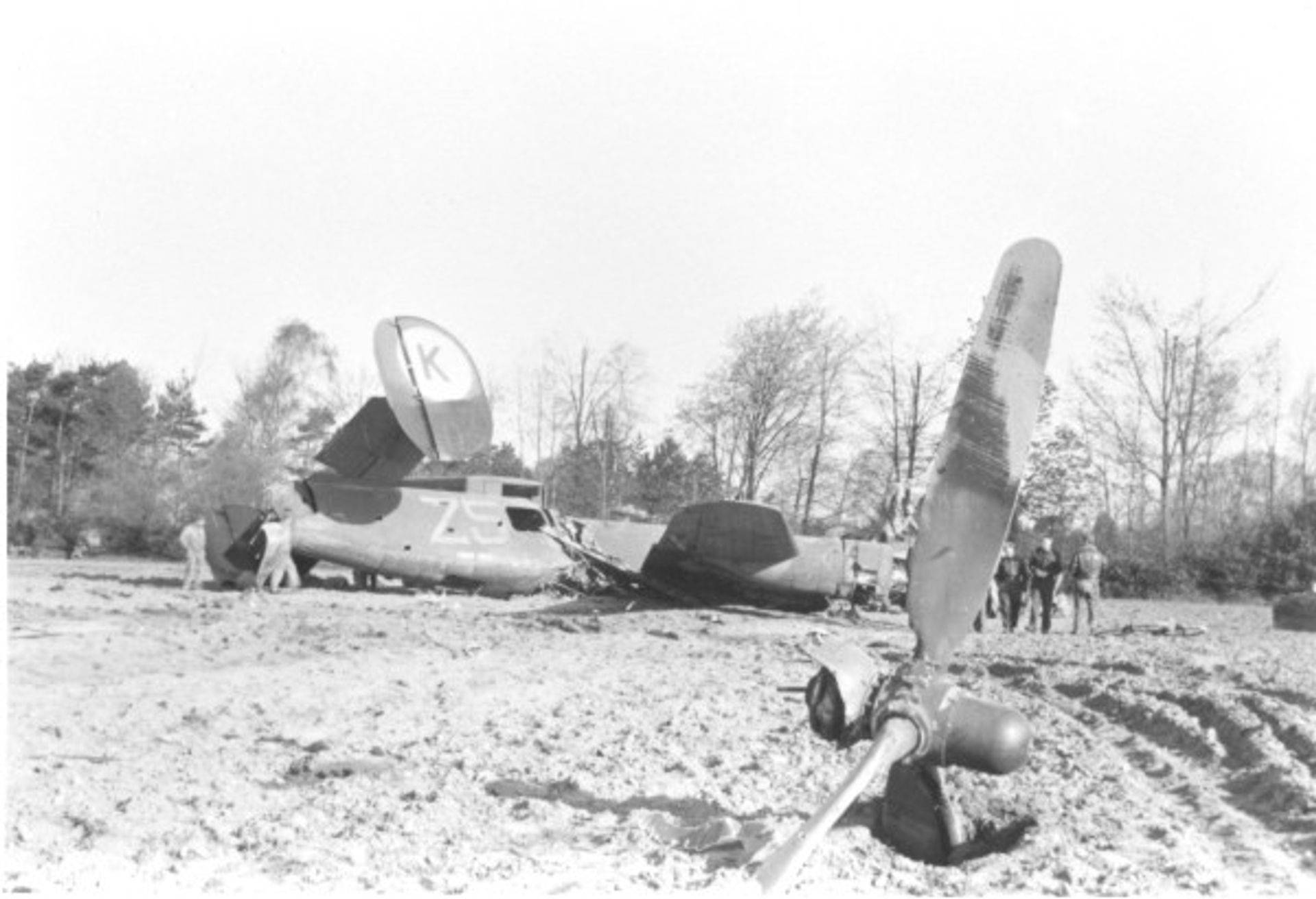
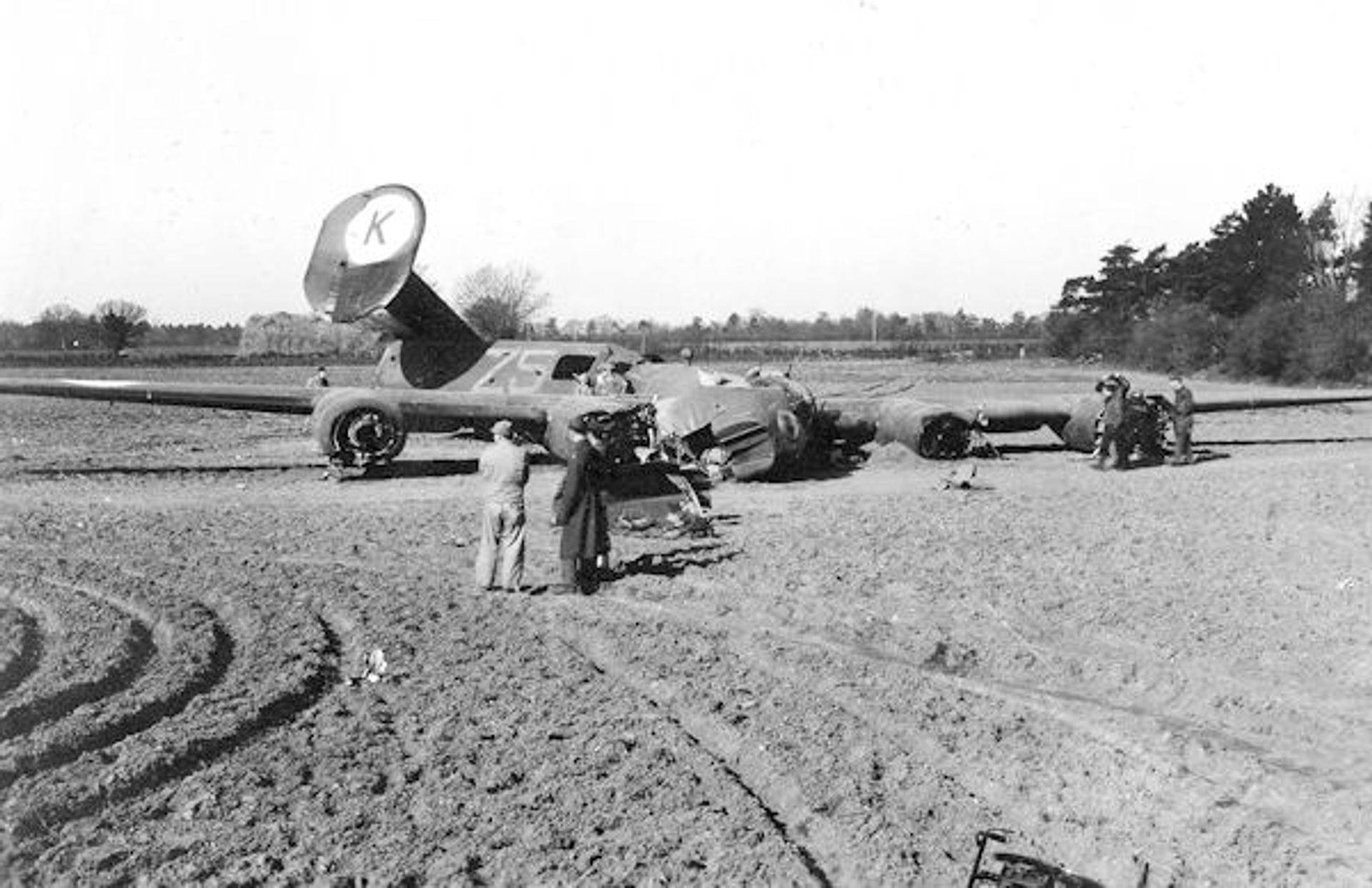

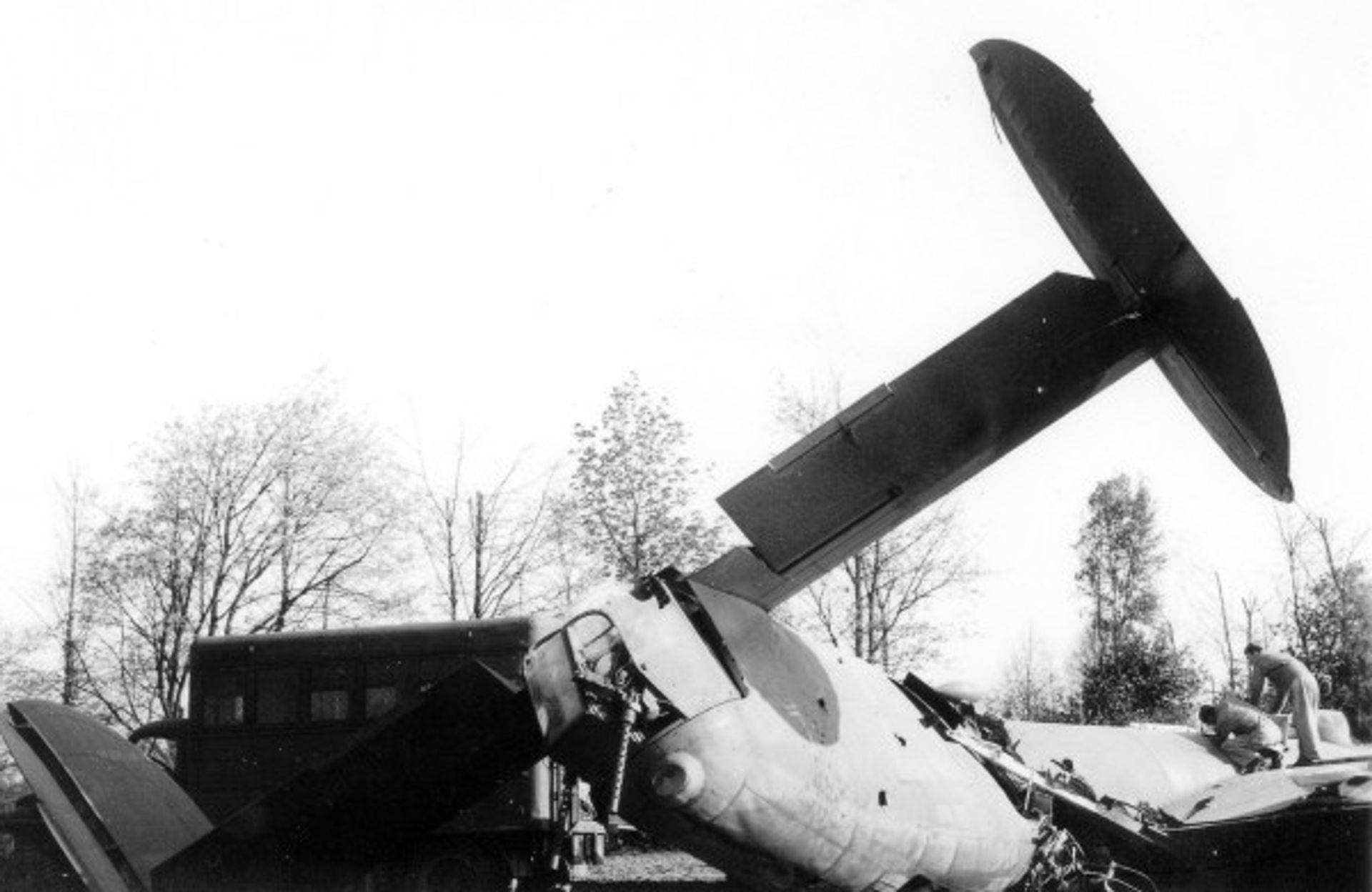
Wreck of 42-100357 Vale Oregan morning of April 23, 1944
(Courtesy: Mike Bailey & Ian McLachlan)
Contemporary 458BG public relations press release credited Stilson’s gunners with destroying their attacker. More credence can be given to the Silver Star subsequently presented to Stilson for his courage. Years later, another 458BG flier, Glenn R. Mattson, confessed to his own comparative lack of heroism that night. Writing in the Second Air Division Newsletter, Glenn recalled, “22 April 1944 was a stand down day for our crew so we did not have to fly. . . I sat around all day. Went to Dome trainer for a while and got bored. I decided to get a pass and go to Norwich. It was refused. I said to hell with them and went AWOL. I got dressed and went out the Burma Road. As usual I got all drunked up. Some English sailor sold me a bottle of some very bad booze, bathtub type. At about 10.30 at night, I am staggering along a ditch at the end of the runway when I heard the darned awfullest noise. Couldn’t believe what I was hearing, It was anti-aircraft guns going off all around me. Out of the dark came this B-24 roaring down the runway and over the top of me. Pursued by a Ju88 or a Me110. Jumping for the ditch, I lay there for awhile until it quieted down. I took off for the debriefing hut with my bottle of booze. I got there as the crews were coming in. These guys looked like ghosts, pallid and drawn and scared from their dreadful experience. One guy came in carrying his popped parachute. He looked like he could use a drink, so I offered him one from my bottle. That was the last time I saw that bottle. . .”
A more sober view of events is offered by 458BG pilot, Captain John L. Weber. “We were on a long final approach to Horsham, gear and flaps down, when tracers started coming from behind us, passing on below and going on ahead. I yelled over the intercom to Callahan, the tail gunner, ‘Do you see a fighter back there?’ He came right back with, ‘Yeah, I see him’. I hollered, ‘Why aren’t you firing?’ He came back with, ‘I’m waiting for him to get in range.’ With that, the entire crew came on the intercom laughing and yelling for Ray to start firing. About this time the runway lights went out and the tower advised everyone to disperse and try to shake off the fighters. We went up the Wash and circled until things quietened down, then came back to land.
“My next recollection is of standing at the bar in the Combat Crew Mess when ‘The A-rab’, who if my memory is correct was Lieutenant Stilson’s co-pilot, Lieutenant Worton, came in the door dragging his open parachute behind him. As I remember, we had a difficult time getting him to leave the bar and report in to his squadron. He had baled out at low altitude and it had taken him quite a long time to find his way home in the dark.”
To sooth nerves still jangling, a late night movie, Going My Way, was organized and number of combat crewmen soon found themselves absorbed in the story of Bing Crosby as a crooning Irish Priest overcoming gentler adversities in his New York parish. As his Group settled, Colonel Isbell took stock. “We stood to lose 26 aircraft that night, each with at least 10 members aboard. We lost only two aircraft and nine men. It was a miracle that we only lost nine of the 20 on board these aircraft”.
S/Sgt Kenneth Katten – Distinguished Flying Cross

G.O. No. 126, Hq 2d BD
10 July 1944
KENNETH KATTEN, 19024629, Sergeant, Army Air Forces, United States Army. For extraordinary achievement, while serving as Gunner of a B-24 aircraft on a bombing mission to Germany, 22 April 1944. Sergeant Katten’s aircraft was attacked by enemy intruder fighters as they returned to their home base at dusk. Two engines were shot out, two gunners wounded, and a fire started in the waist section by enemy cannon fire. Given the order to bail out, Sergeant Katten informed his Pilot that two crew members were wounded, volunteered to remain and protect them, and as they crash landed, threw himself over them to keep off flying debris. Sergeant Katten suffered a broken back and both legs paralyzed as a result of the crash landing. The courage and extraordinary heroism displayed by Sergeant Katten on this occasion reflect the highest credit upon himself and the Armed Forces of the United States. Entered military service from California.
Loading list & B-24J-95-CO 42-100357 Z5 D Vale Oregan
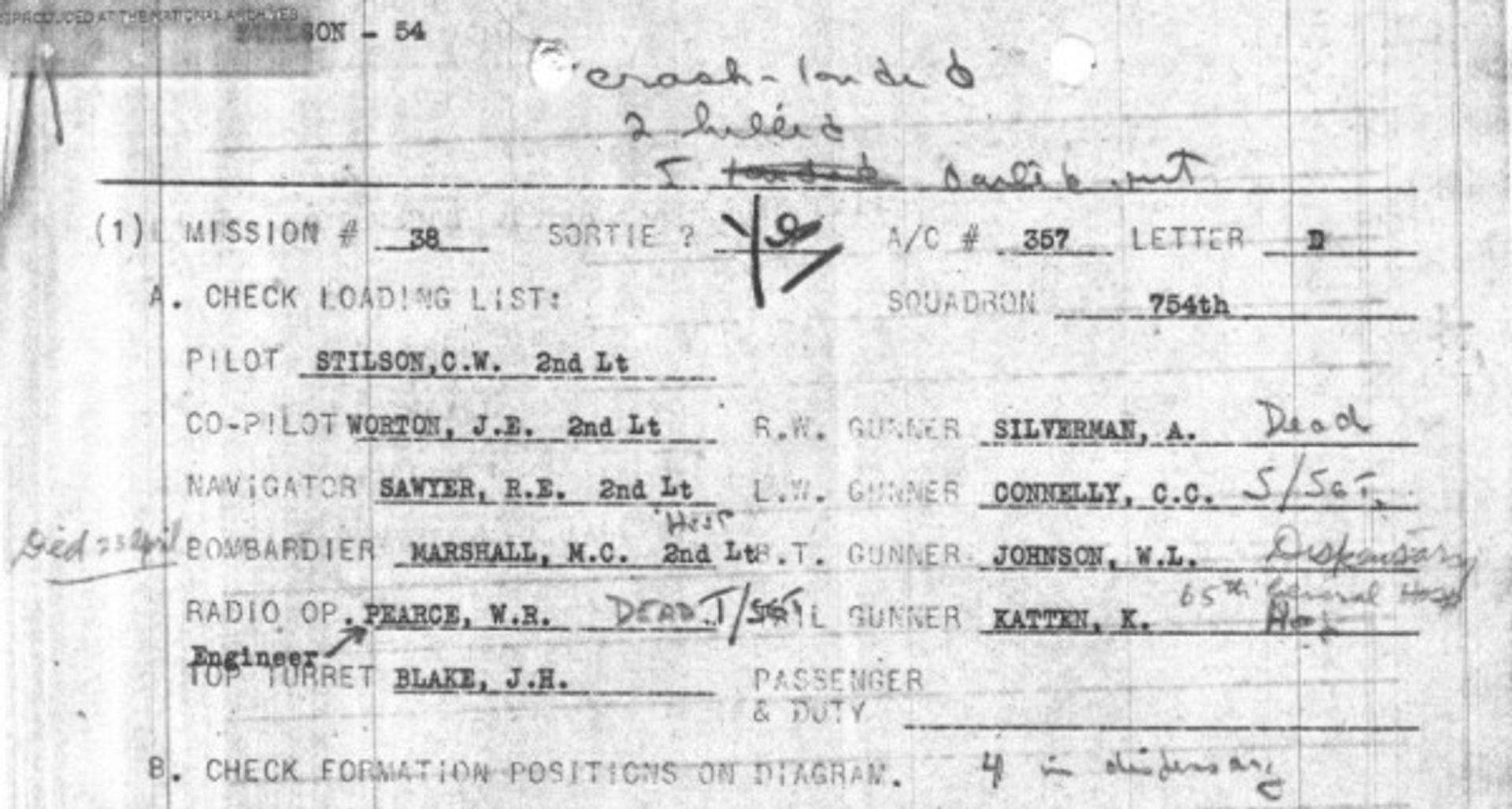

“Red” Stilson looks over the scene on the morning of April 23, 1944
Photo: Brian Stilson
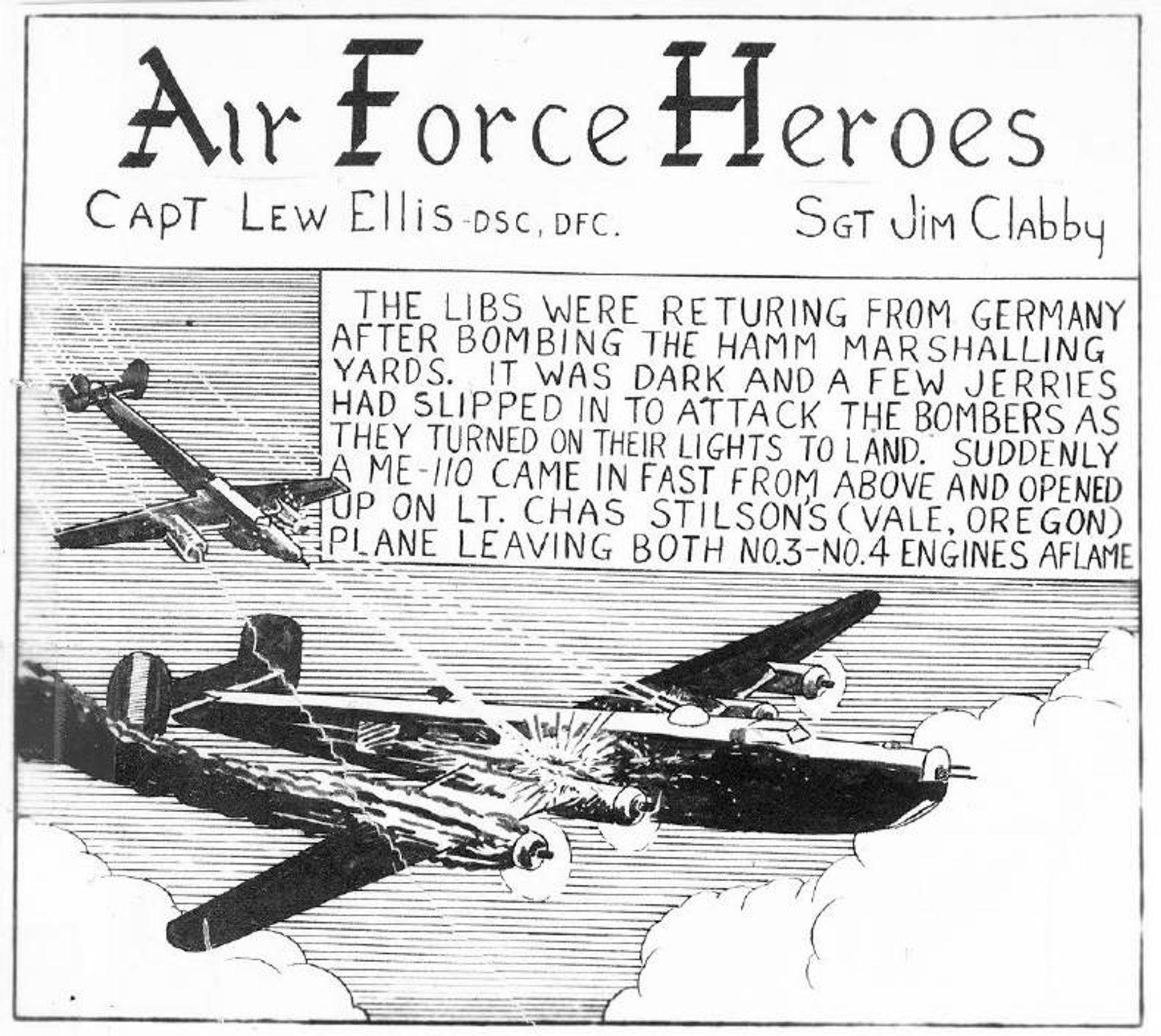
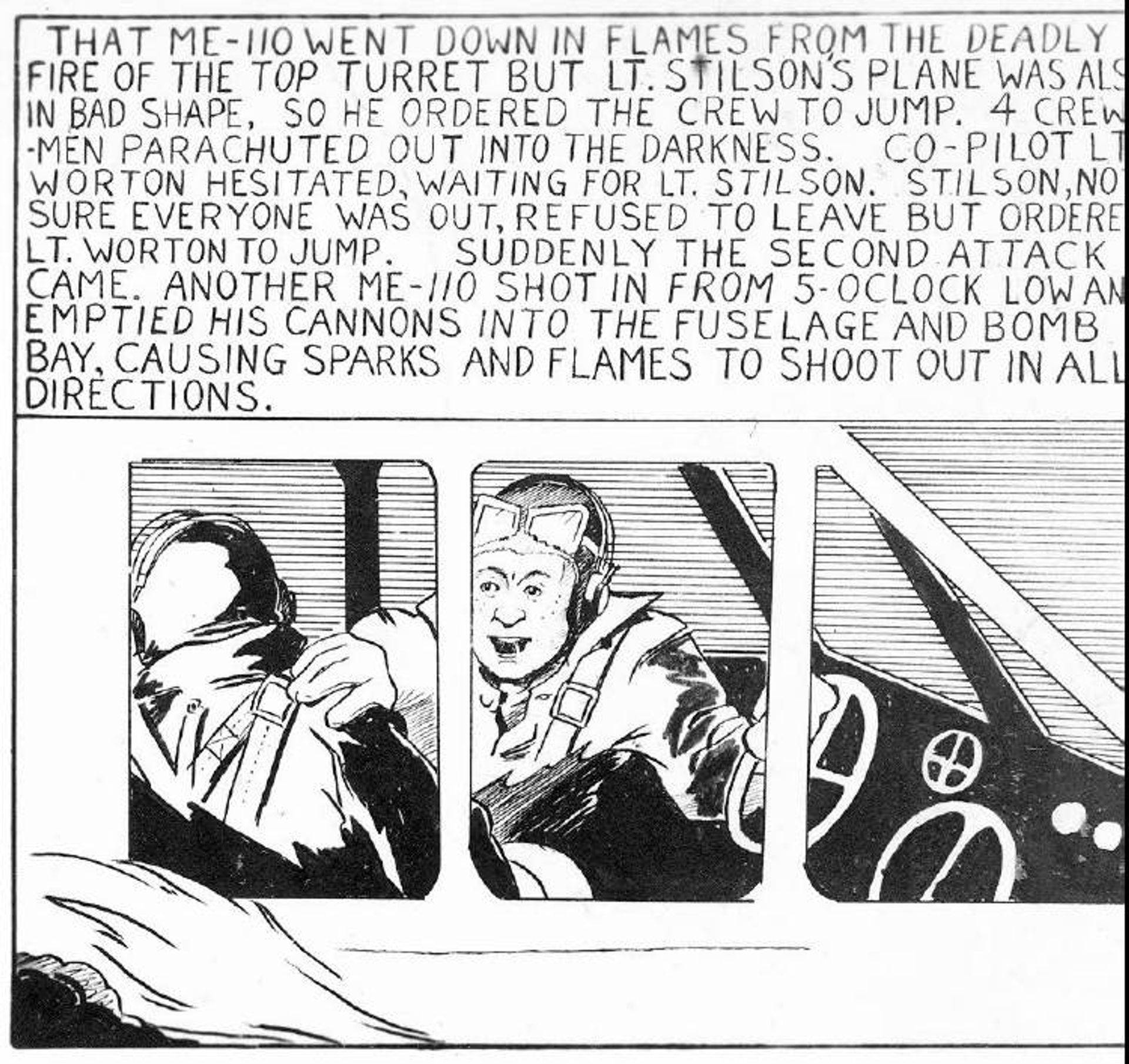

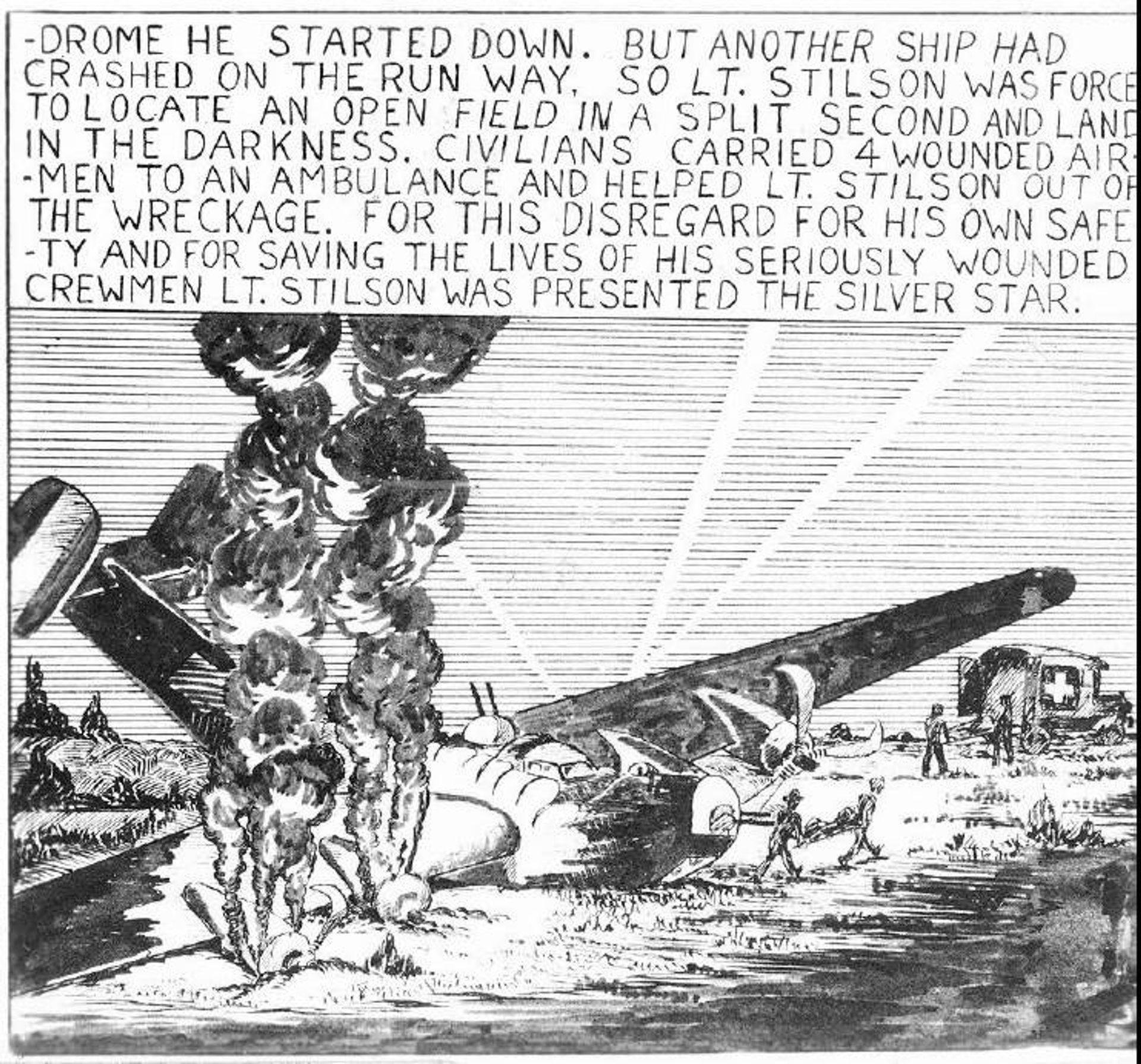
Courtesy: John Blake
B-24H-15-FO 41-52404 Z5 Q Belle of Boston
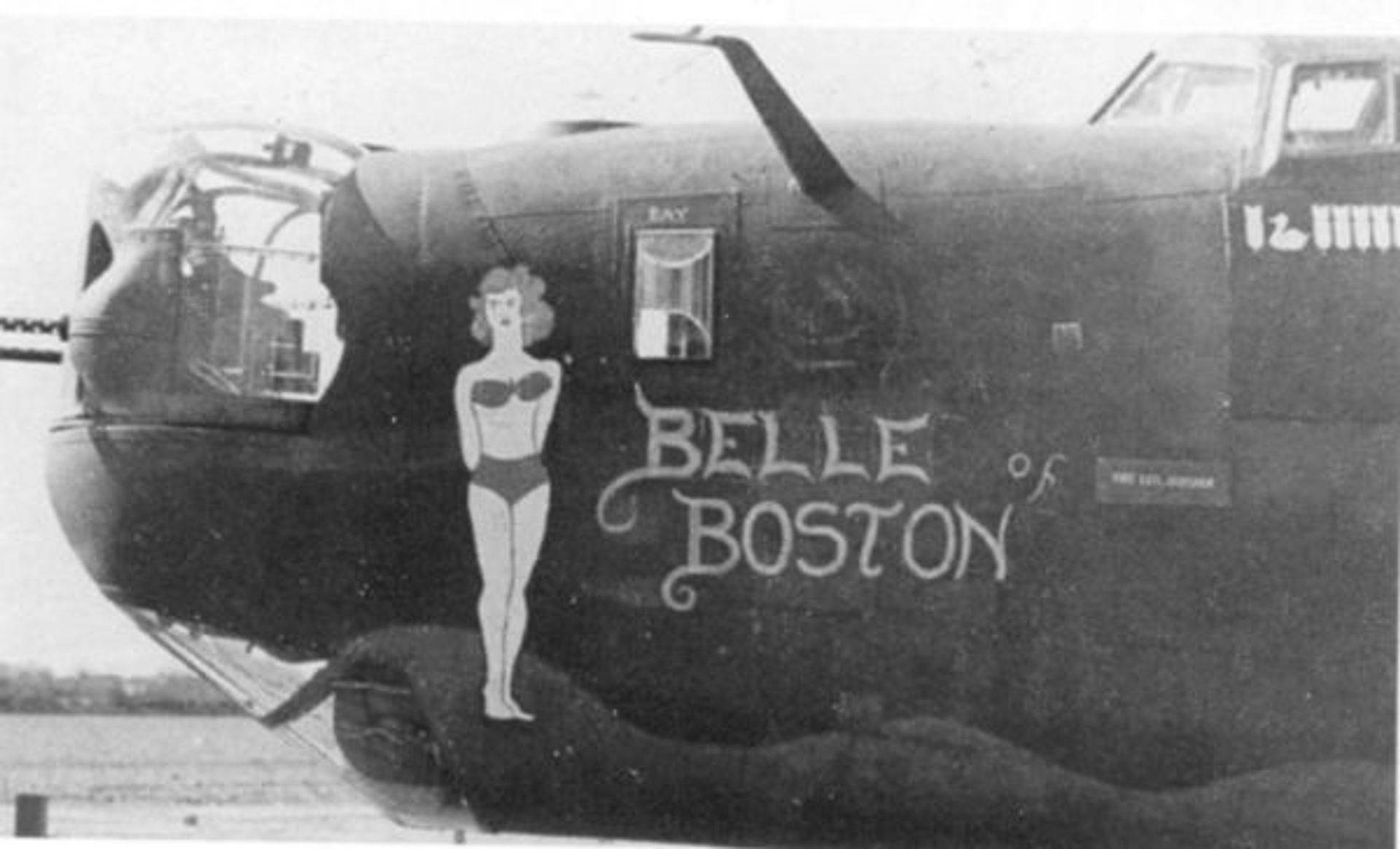
Crew 54 flew this A/C overseas and on several missions. This aircraft crashed on take-off on May 8, 1944 with the Kingsley Crew
Photo: George Reynolds
Silver Star & Distinguished Flying Cross
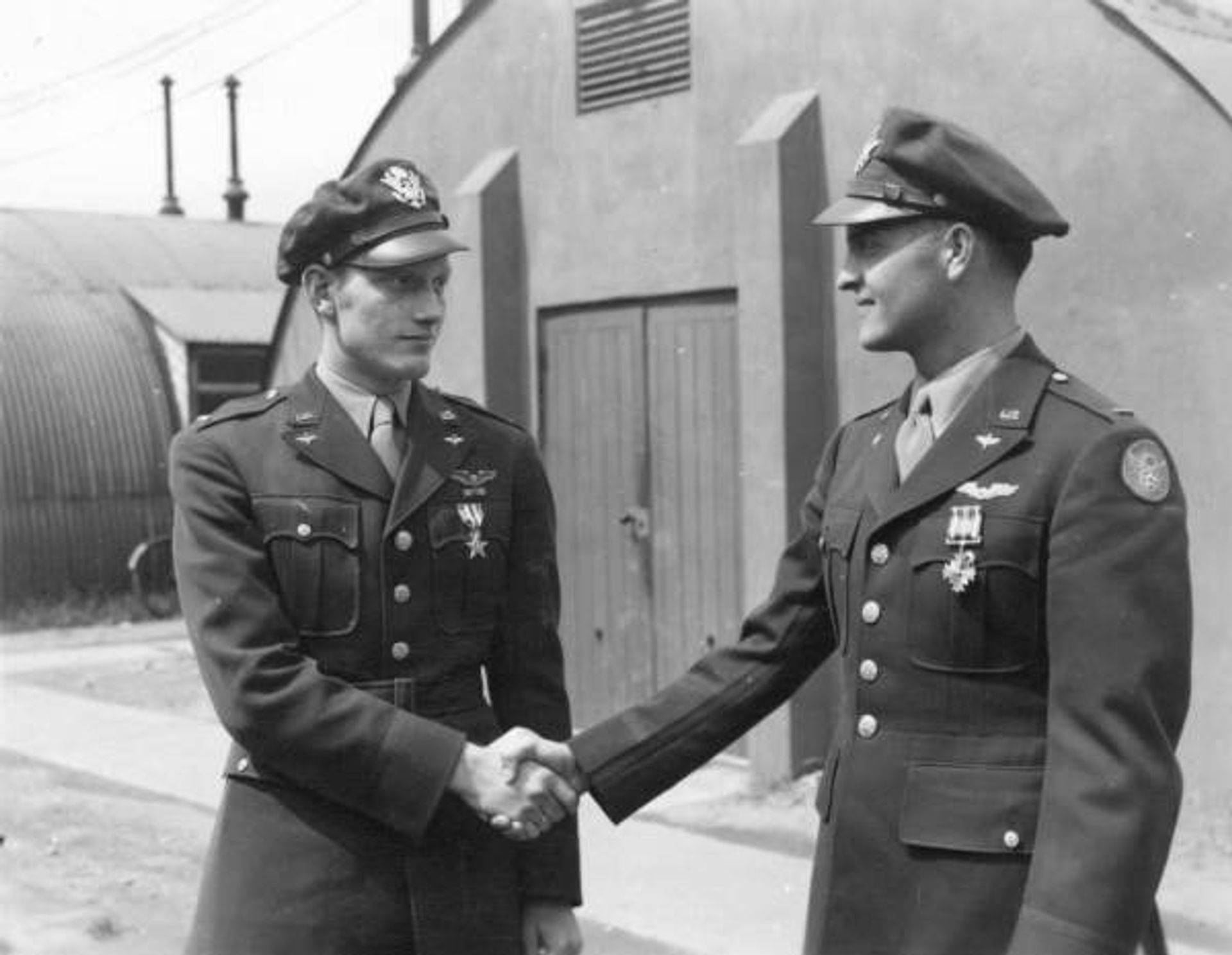
1Lt Charles W. Stilson and 1Lt Robert O. Nixon (Navigator, Crew 73) congratulate each other after receiving their awards
Photo: AFHRA
